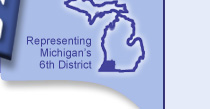HOMEPAGE > The Digital Television Transition
- Congress passed legislation in 2006 to improve television for consumers and to help public safety officials communicate better.
- On September 11th we learned that our First Responders cannot adequately communicate in times of disaster.
- The law requires broadcasters to complete their transition to digital and return some of their spectrum for First Responders.
- Some of the spectrum will also be auctioned, and $1 billion will go toward communications equipment for First Responders.
- Analog, over-the-air television will end midnight, Feb. 17, 2009.
- If you get TV from a cable, satellite, or telephone company, your provider will handle the conversion for you.
- If you use an analog television manufactured after March 1, 2007, or a digital television, you need not take any action.
- If you use an old, analog television with an over-the-air antenna, after Feb. 17, 2009, you must: 1) subscribe to a cable, satellite, or telephone provider for TV service; 2) purchase a digital television; or 3) obtain a converter-box.
- Converter-boxes should become widely available in early 2008.
- The converter boxes are expected to cost between $50 and $75, and will improve the picture of even old, analog television sets.
- The government is making up to two $40 coupons available per household for those who want help purchasing the converters.
- Consumers may request coupons starting January 2008.
As Ranking Member of the Telecommunications and Internet Subcommittee, I recognize that consumers in our corner of Michigan, and across the country, are concerned about how the DTV transition will affect their television sets, particularly in light of tight family budgets. This is a fact that I believe we should never lose sight of in this debate. I’ve worked hard to ensure that no family is left behind in the DTV transition.
It is important to remember that the vast majority (about 85%) of American households subscribe to cable or satellite television. As such, most televisions in those households rely on the cable company (through the coaxial cable) or the satellite television company (through the set-top box) to deliver the broadcasters’ signals to their televisions; those televisions will NOT be affected by the DTV transition.
However, a minority (about 15%) of American households do not subscribe to cable or satellite television, thereby relying on over-the-air television reception (“rabbit ears” or roof top antennae). Analog, over-the-air television will no long be broadcast after midnight, February 17, 2009. For those households, and those with analog sets not hooked up to cable or satellite, one would either need to purchase a digital television or get a digital-to-analog converter box for their existing analog television in order to continue to receive over-the-air broadcast television. Of course, in the alternative, households that rely exclusively on over-the-air reception might simply decide to subscribe to cable or satellite television at that point (and no longer rely on over-the-air reception).
Therefore, some segment of the American people may need a digital-to-analog converter box to continue using their existing analog television sets after the end of the DTV transition. Given the importance of broadcast television as a primary source for local news, weather, traffic and emergency alerts, not to mention entertainment, we cannot overlook that segment of our population. The converter boxes are expected to cost between $50 and $75, and will improve the picture of even old, analog television sets. The government is making up to two $40 coupons available per household for those who want help purchasing the converters.
This would be financed from the proceeds from the Federal Communication Commission’s (FCC) auction of the portion of the public’s airwaves that the broadcasters will return at the end of the DTV transition that is not otherwise reserved for public safety interoperability. As part of the DTV transition this is and will be a massive consumer education campaign by the FCC, broadcasters, cable and satellite companies, television manufacturers and retailers.
The value of the digital broadcasting format to the consumer is that it enables a broadcaster to transmit, over-the-air, ultra-crisp, high definition pictures and sound, which is of dramatically higher quality than traditional analog broadcast. In addition, because of digital compression technology, broadcasters will also be able to deliver to the consumer up to six different (albeit not necessarily high definition) digital channels over-the-air; in the analog world, broadcasters are only able to deliver one channel.
But that is not the end of the story. It is vitally important to note that at the end of the DTV transition, when broadcasters are to return their original portion of the public’s airwaves, the federal government has reserved a significant portion of those public airwaves for our nation’s public safety first responders to enable interoperable radio communication. Interoperable radio communication enables local firefighters and police to communicate with one another, neighboring localities, and their counterparts at the state and federal level all on the same radio channel during a crisis.
Particularly in the wake of 9/11 and Hurricane Katrina, the need for interoperable radio communication is all the more apparent; we have witnessed the calamity caused when our public safety first responders, at all levels, are not able to effectively communicate with one another during a crisis. A lack of such interoperability has resulted in lives being lost, and this is why there is such a dire need for a timely completion of the DTV transition. Until then we will not be able to get the broadcasters to return their original portion of the public’s airwaves and get it into the hands of public safety.
While ending the DTV transition is critically important to public safety, we must ensure that the transition is as easy on the consumer as possible, and I will fight to make sure that that is the case.
|




